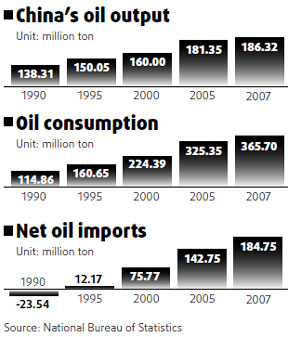China is on the threshold of the long-awaited fuel tax implementation.
As unveiled by the reform draft released last week, the government plans to abolish six categories of fees now charged for road tolls, waterway maintenance fees and waterway management fees, and raise the consumption tax on gasoline from 0.2 yuan to 1 yuan per liter, and diesel from 0.1 yuan to 0.8 yuan per liter. The plan is scheduled to take effect at the beginning of next year.
To soothe the public's worry that the increased fuel tax may boost oil prices, the government ensured the public that the pump prices will not rise after the implementation of the plan.

The plan offers vehicle owners further relief with a plan to gradually abolish toll fees on 60 percent of the second-tier roads in the country. It is expected that more than half of the toll roads will become toll free.
Price reforms of oil products will also be accelerated under the plan. The current government-dictated pricing system has helped at times to dampen inflation when international oil prices were high, but as the oil prices in international market have plummeted to below $50 a barrel it seems unreasonable that the domestic prices are still at a higher level.
Now the pricing mechanism reform is on the government's agenda, as the draft encourages domestic fuel prices to be more directly linked with international prices. Since the government promises the retail prices will not rise, it is expected the profit margins of the domestic oil corporations will be squeezed.
A long overdue move
The fuel tax was initially proposed in the 1997-enacted Road Law, which suggested levying a fuel surcharge instead of road maintenance fees.
But the proposal didn't become reality until now. The reasons for the delay were various, among which the toughest one was conflicting interests between various government departments.
As the road maintenance fees are replaced by the higher fuel consumption tax, the money will go to tax bureaus instead of traffic management bureaus.
Under the former principle of "those who charge should be those who construct", the fees gained from roads invested by local governments should go to local finances. If the tax is levied, part of the money will go to the State treasury. What's more, re-employment for the 300,000 fee-collectors will be a big challenge.
Skyrocketing international oil prices in recent years made the policymakers more cautious about levying the fuel tax for fear that it would lead to inflation, a major concern for the government just one year ago.
The southern province of Hainan, however, began collecting 30 percent fuel surcharge as early as 1994 which combined four kinds of fees, including road maintenance fees, road tolls, bridge tolls and administrative fees. But what it left is a cash-strapped local government.
Still a must
Despite various difficulties ahead, the fuel tax is still a must, given the unprecedented expansion of automobiles in China and the low efficiency of energy use.

As shown in the charts, the last five years have seen an explosive growth in China's car numbers. From 2003 to 2007, the number expanded by one million every year, making 2007's volume of civilian vehicles 2.2 times higher than 2000, and the volume of household cars 3.7 times more than 2000.
The latter, which is the most important engine of China's auto industry, soared at the speed of 20 percent in recent years. Last year, the owner rate of cars per hundred urban households reached 6.1, which was 9.1 times higher as that of 2001.
China has become world's second largest auto market and the third largest manufacturer.
Along with the auto growth came the hike in oil consumption. The total consumption of gasoline and diesel oil in 2007 jumped to 55.19 million tons and 124.93 million tons, a 59.2 percent and 86.4 percent increase from 2000 respectively. China's oil import dependency reached 50 percent in 2007.
Apart from the huge energy pressure, the increasing car ownership rate is the major contributor to traffic congestion and air pollution.
The ever faster process of urbanization is also to blame for the great energy pressure, as an average urban resident consumes three times the energy as that of a rural resident. Meanwhile, 577 million urban residents, or 43.9 percent of the nation's population, will enormously raise the energy consumption in the public transportation sector.